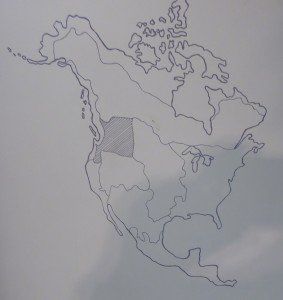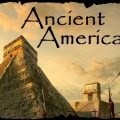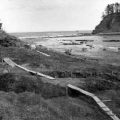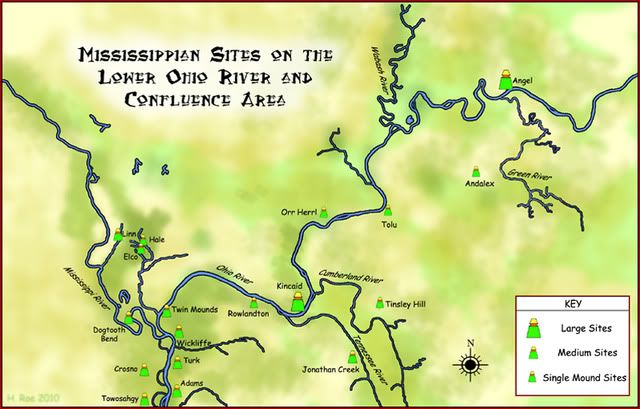Six thousand years ago, American Indians had been living throughout North America for thousands of years. They followed a lifestyle based hunting, fishing, and gathering that was determined in part by the environment. In the coastal regions, for example, Indian people subsisted on a marine diet, while in other areas plant food were more important. In some areas, the people followed a seasonal nomadic round travelling to different areas to gather specific resources. In other areas, where resources were abundant, such as the coastal areas, there was relatively little nomadism.
At this time six thousand years ago there were probably several hundred distinct Indians groups with their own languages, religions, and cultural patterns. Archaeologists often refer to this time period as the Archaic. In an article in the Utah Historical Quarterly Alan Schroedl writes: “The name Archaic is not meant to imply a backward or outmoded style of life; on the contrary, the Archaic lifeway was the most dynamic and flexible mode of adaptation that ever developed in the New World.”
During the Archaic, there was a great deal of regional specialization. However, the archaeological record for this time is a bit spotty with many geographic areas blank in terms of archaeological knowledge.
California and Oregon:
In California, Indian people fashioned the Running Man geoglyph on the shore of Searles Lake. Geoglyphs are earthen images which were made by scraping away the stable dark desert pavement to reveal the lighter soil underneath (these are also called intaglios or engravings) or by placing boulders and/or large cobbles to form figures. The rock alignment which forms the figure is about 9 feet long.
In California, the culture which archaeologists call Martis expanded eastward across the Sierra Nevada where it became the cultural ancestor of the Washo Indians.
In California, Indian people were living near the present-day Hoopa Reservation. They were using wide-stemmed projectile points, scraping tools, and milling implements.
Indian people established a fowling and fishing station on Nightfire Island on Lower Klamath Lake in Oregon.
Washington and Idaho:
In Washington, immigrants from the Great Basin moved into the Five Mile Rapids area bringing with them new kinds of projectile points and other objects.
In Idaho, Indian people began to live in the Island Park Reservoir area.
At an Indian graveyard near the Little Salmon River in Idaho, 22 people were buried.
The Southwest:
The period which archaeologists call Black Rock began in Utah. According to archaeologists C. Melvin Aikens and David B. Madsen in an article in the Handbook of North American Indians: “In conjunction with a dramatic increase in occupation sites during the early portion of this period, there was an apparent broadening of settlement patterns with a growing emphasis on the exploitation of upland zones.”
In Utah, Indian people were using Spotten Cave at the south end of Utah Valley. In an article in Utah Historical Quarterly, archaeologist Joel Janetski writes: “Spotten Cave was likely used by Archaic peoples as a temporary stopover as they moved from the Goshen Valley bottoms to the uplands of Long Ridge or the Wasatch Front.”
In the Colorado River Plateau area of Utah and Arizona, Indian people were making representational petroglyphs which archaeologists refer to as the Glen Canyon Linear Style. The figures include shamanistic humans as well as animals and some abstract elements.
In Colorado, the period which archaeologists call the Castle Valley Phase began. This phase was characterized by a decrease in population as a result of people moving into Utah.
The Northeast:
In Massachusetts, Indian people were using the Middleborough site as a ceremonial site. Among the artifacts which they left at the site were thousands of paint stones: soft rocks, primarily of hematite and graphite, that can be scratched or ground into powder and then mixed with fats to make paints. These paints were then applied to the skin and to clothing as decoration. In an article in American Archaeology Jennifer Weeks reports: “Other ceremonial items included pebbles polished by wear, quartz crystals, and slabs of arkose, a type of local sandstone.”
While there were no burials at this site, burials in nearby Wapanucket have graves which are lined with the slabs of arkose.
In Maine, Indian people were using a weir to harvest fish from Sebasticook Lake.
Southeast:
In the Southeast populations began to increase at about this time.
In Tennessee, Indian people created a pictograph deep in a cave where there is no light. The art depicts a human and a quadruped. In an article in American Archaeology, Melissa Montoya writes: “This pictograph is the oldest of hundreds of pieces of cave art and open-air rock art that make up a large scale composition in which prehistoric people altered their physical landscape in accordance with their spiritual beliefs.”
In Louisiana, Indian people constructed two mounds at Monte Sano Bayou. Mound A is a conical structure 6 meters high. It was built in a single construction episode. Both mounds were built to mark places where the cremation of select individuals had taken place.
Arctic and Alaska:
In the arctic region, Inuit prehistory began with the Arctic Small Tool Tradition. This was a technology which was characterized by hafted small chisel-like blades which were used for working wood, bone, and ivory. Steve Langdon, in his book The Native People of Alaska, writes: “Because of its distribution, this tool tradition is considered characteristic of the earliest Eskimo population.”
In Alaska, the Ocean Bay Tradition began at the Larsen Bay site.
Illinois and Missouri:
In Illinois, the people who were living at Helton village the Koster site were harvesting fish in large numbers. They were smoking part of the fish harvest to preserve it for use in the winter months. Their village covered about six acres and had a population of 100 to 150 people. In addition to harvesting fish, the Helton village people also hunted mammals, such as deer, take waterfowl, and gathered plants and nuts. They wove grasses into mats and cloth and they tanned hides to make leather items.
In Missouri, Indian people built a village of 10 log homes. Each of the homes was about 15 by 17 feet in size. The population of the village was about 100. They were cooking food in an underground oven and they had underground storage pits for food.
Yellowstone National Park:
In Wyoming, Indian people were using the Fishing Bridge Point site in present-day Yellowstone National Park. Archaeologist Douglas MacDonald, in his book Montana Before History: 11,000 Years of Hunter-Gatherers in the Rockies and Plains, writes: “The presence of Early Archaic sites on the Yellowstone Plateau shows that Early Archaic hunter-gatherers moved into the uplands, at least during the warmer months, to hunt animals and collect the plethora of plant resources available around the shores of Yellowstone Lake.”




Leave a Reply